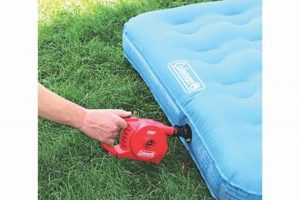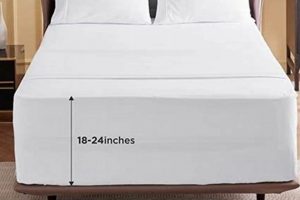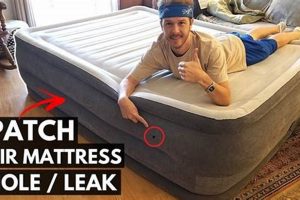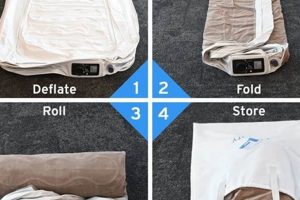The process addresses repairing punctures or tears in inflatable sleeping surfaces, typically used for camping, temporary bedding, or guest accommodations. An example involves identifying the leak, cleaning the surrounding area, applying an adhesive, and covering the defect with a patch to restore the air-holding capacity of the mattress.
Restoring an air mattress extends its lifespan, prevents waste, and saves resources otherwise expended on purchasing a replacement. This approach is economically prudent and environmentally conscious, reducing landfill burden and promoting sustainable consumption habits. Historically, methods for mending inflatable items have evolved from rudimentary solutions like using heated tar to sophisticated adhesives and specialized patching materials.
The following sections detail the necessary materials, step-by-step procedures, and preventative measures to ensure a successful and lasting repair. Subsequent topics will include identifying leaks, preparing the surface, applying the patch, and maintaining the repaired area to maximize the utility of the sleeping surface.
Essential Considerations for Air Mattress Repair
Effective air mattress maintenance hinges on meticulous preparation and precise execution. Adherence to the following guidelines can significantly improve the longevity of the repair and the overall lifespan of the mattress.
Tip 1: Location Identification is Paramount: Thoroughly inspect the mattress to pinpoint the source of the leak. Submerge the inflated mattress in water or apply soapy water to the surface, observing for bubble formation to identify the puncture point.
Tip 2: Surface Preparation is Critical: Clean the area surrounding the puncture with isopropyl alcohol to remove dirt, oils, or residues that may impede adhesive bonding. A clean surface ensures a secure and durable patch application.
Tip 3: Patch Size Matters: Select a patch that extends at least one inch beyond the perimeter of the puncture. An adequately sized patch distributes stress and prevents the propagation of the tear.
Tip 4: Adhesive Application Technique: Apply a thin, even layer of adhesive to both the patch and the mattress surface. Allow the adhesive to become tacky before joining the surfaces to maximize adhesion strength.
Tip 5: Pressure Application Enhances Bonding: After applying the patch, exert firm, even pressure across the entire surface for a minimum of five minutes. This action facilitates a strong bond between the patch and the mattress material.
Tip 6: Cure Time is Essential: Allow the adhesive to cure completely, as per the manufacturer’s instructions, before inflating the mattress. Premature inflation can compromise the integrity of the repair.
Tip 7: Reinforcement for Larger Tears: For tears exceeding one inch, consider using a reinforcement fabric underneath the patch to provide additional structural support. This measure prevents the patch from peeling or detaching under pressure.
By implementing these recommendations, individuals can enhance the success rate of air mattress repairs, ultimately extending the useful life of the product and minimizing unnecessary replacements.
The subsequent sections will explore preventative strategies to minimize the occurrence of punctures and tears, further safeguarding the investment in an air mattress.
1. Leak identification
Pinpointing the source of escaping air is the foundational step in the process. Accurate identification directly influences the effectiveness and durability of any subsequent repair efforts.
- Aural Detection and its Limitations
Listening for hissing sounds often provides an initial indication of a leak. However, this method is most effective in quiet environments and struggles with minute punctures or leaks located within the mattress’s internal structure. The absence of audible hissing does not negate the possibility of a leak, potentially leading to a misdiagnosis and ineffective patching attempt.
- Soapy Water Solution: Principle and Application
Applying a mixture of soapy water to the inflated mattress surface relies on the principle of surface tension. Escaping air creates visible bubbles at the leak site, even for extremely small perforations. The efficacy depends on even application of the solution and careful observation under adequate lighting. Inadequate coverage or poor lighting can lead to missed leaks, requiring repeated application.
- Submersion Method: Comprehensive Leak Detection
Submerging the inflated mattress in water offers a comprehensive leak detection strategy. Escaping air manifests as a stream of bubbles, facilitating precise pinpointing of the puncture. Challenges include managing the mattress’s buoyancy and ensuring complete submersion of all surfaces. Large mattresses may require significant water volumes and physical effort.
- Marking the Leak: Precision for Patch Application
Once identified, clearly marking the leak location with a permanent marker is essential. Accurate marking guarantees precise patch placement, maximizing the likelihood of a successful seal. Indistinct or misplaced markings can result in the patch failing to fully cover the puncture, leading to continued air leakage.
These diverse methods of pinpointing air loss underscores the necessity of accurate leak identification. Without a precise understanding of the leak’s location, efforts will be misdirected. Prioritizing thorough and accurate leak identification ensures a more robust and long-lasting repair.
2. Surface Preparation
Prior to initiating any repair to an inflatable mattress, meticulous preparation of the area surrounding the puncture is paramount. This preparatory stage directly impacts the adhesion of the patch and the longevity of the repair, influencing the overall success of the undertaking.
- Cleaning: Removal of Contaminants
The presence of dirt, oils, or residues on the mattress surface impedes the formation of a strong adhesive bond. Isopropyl alcohol serves as an effective cleaning agent, dissolving contaminants and creating a clean substrate for patch application. Incomplete cleaning results in a weakened bond, increasing the likelihood of patch failure and air leakage.
- Abrasive Treatment: Enhancing Adhesion
Lightly abrading the surface with fine-grit sandpaper or a similar abrasive material creates microscopic irregularities that increase the surface area available for adhesive bonding. This process improves the mechanical interlocking between the patch and the mattress material. Excessive abrasion, however, can damage the mattress, potentially exacerbating the initial problem.
- Drying: Evaporation
of SolventsFollowing cleaning, allowing the treated area to dry completely is crucial. Residual solvents or moisture can interfere with the curing process of the adhesive, compromising its strength. Forced drying with a clean cloth or gentle heat accelerates evaporation. Failure to ensure dryness can result in a weak, unstable bond that degrades over time.
- Area Definition: Precise Patch Placement
Clearly defining the area to be patched with masking tape or a similar removable material provides a visual guide for adhesive application and patch placement. This ensures that the adhesive is applied only to the necessary area, preventing excess adhesive from spreading onto unintended surfaces. Precise definition minimizes cleanup and contributes to a professional-looking repair.
The combined effect of these surface preparation techniques is a superior bond between the patch and the inflatable mattress. Each element contributes to a clean, receptive surface that maximizes the adhesive’s efficacy, significantly improving the chances of a successful, long-lasting repair.
3. Adhesive Selection
The integrity of an air mattress repair is intrinsically linked to the choice of adhesive. The effectiveness of “how to patch air mattress” hinges on selecting an adhesive compatible with the mattress material, typically vinyl or rubber. Incompatible adhesives fail to create a durable bond, leading to patch detachment and renewed air leakage. For instance, using a rigid adhesive on a flexible vinyl mattress results in cracking and separation under stress. Selecting a flexible adhesive specifically designed for inflatable products is therefore essential.
Consider the practical implications of adhesive choice. Cyanoacrylate adhesives (super glue) offer rapid bonding but become brittle and inflexible, making them unsuitable for air mattress repair. Conversely, contact cement creates a strong initial bond but may require specialized application techniques and ventilation. Vinyl repair adhesives, typically based on solvents, offer a balance of flexibility, strength, and ease of application. These adhesives dissolve the surface layer of the vinyl, creating a chemical bond that is more resistant to peeling and tearing. Furthermore, water resistance is a critical factor, preventing bond degradation from moisture exposure.
In summary, adhesive selection is not merely a supplemental consideration but rather a primary determinant of repair success. The correct adhesive creates a durable, flexible, and waterproof seal, extending the lifespan of the air mattress. Challenges in adhesive selection often arise from the misidentification of the mattress material or the use of generic adhesives not formulated for flexible substrates. Prioritizing material compatibility and adhesive properties ensures a reliable and long-lasting repair solution.
4. Patch application
The procedure of affixing a repair material to an inflatable mattress directly determines the success of rectifying leaks. Incorrect patch application negates all prior efforts in leak identification and surface preparation, rendering “how to patch air mattress” a futile exercise. A real-world example involves applying a patch askew, failing to completely cover the puncture. This results in continued air leakage despite the attempted repair. The importance of precise execution cannot be overstated; a misapplied patch is tantamount to no patch at all.
Further analysis reveals the dependence of patch longevity on the technique employed. Applying the patch with entrapped air bubbles creates weak points, susceptible to stress and eventual failure. Proper technique dictates uniform pressure across the patch surface during application, ensuring complete contact with the adhesive. Ignoring this principle often leads to peeling edges and premature repair failure, demonstrating the direct correlation between methodology and outcome. Consider a scenario where pressure is applied unevenly; one section of the patch adheres firmly, while another remains loosely bonded, creating a pathway for air to escape over time.
In summary, the effectiveness of “how to patch air mattress” is contingent upon the patch application process. Deficiencies in technique compromise the entire repair effort, regardless of material quality. A commitment to precision and adherence to established best practices ensures a durable and reliable seal, preventing future air loss. The challenge lies in consistently executing the procedure correctly, demanding attention to detail and a thorough understanding of adhesive properties and material behavior.
5. Curing timeframe
The period allotted for adhesive curing significantly impacts the structural integrity and longevity of a patch applied to an inflatable mattress. Insufficient curing time compromises the adhesive bond, increasing the likelihood of repair failure. Therefore, strict adherence to manufacturer specifications regarding curing is paramount for successful air mattress restoration.
- Adhesive Polymerization and Bond Strength
Adhesive curing involves polymerization, the process by which adhesive molecules cross-link to form a solid, durable matrix. Premature inflation of the mattress before complete polymerization prevents the adhesive from achieving its maximum bond strength. As a result, the patch may peel or detach under pressure. For example, solvent-based adhesives require sufficient evaporation time to fully solidify, whereas two-part epoxy adhesives require a specific reaction period to reach their full hardness. Disregarding these requirements leads to a weak, unstable bond that fails under stress.
- Environmental Factors Influencing Curing
Ambient temperature and humidity levels significantly influence the rate of adhesive curing. Low temperatures retard polymerization, extending the required curing time. Conversely, high humidity can interfere with the curing process of some adhesives, preventing complete cross-linking. A typical example involves outdoor repairs in humid environments, where the adhesive may remain tacky for an extended period, even after the recommended curing time has elapsed. Therefore, adjusting the curing timeframe based on environmental conditions is critical for optimal bond strength.
- Stress Application During Curing
Applying stress to the repaired area before complete curing compromises the adhesive bond. Stress can disrupt the polymer network as it forms, creating micro-cracks and weakening the overall structure. For instance, inflating the mattress before the adhesive has fully cured places undue stress on the patch, leading to premature failure. Consequently, it is imperative to allow the adhesive to cure undisturbed for the recommended duration to ensure a robust and long-lasting repair.
- Testing Bond Integrity After Curing
After the recommended curing time, it is advisable to test the bond integrity before fully inflating the mattress. Gentle probing around the patch edges can reveal areas of incomplete adhesion. Any signs of peeling or separation indicate that the curing process was inadequate, necessitating additional cur
ing time or a complete reapplication of the patch. Ignoring these warning signs and proceeding with full inflation risks immediate repair failure and potential damage to the mattress.
In conclusion, the curing timeframe is not a mere procedural step but a critical phase determining the long-term effectiveness of “how to patch air mattress”. Adherence to recommended curing times, consideration of environmental factors, and careful assessment of bond integrity are essential for achieving a durable and reliable repair. Failure to prioritize curing results in a compromised bond, negating the efforts invested in other aspects of the repair process.
Frequently Asked Questions Regarding Air Mattress Repair
The following addresses common inquiries concerning the repair of inflatable mattresses, providing factual information and practical guidance for effective maintenance.
Question 1: What type of adhesive is best suited for repairing air mattresses?
Vinyl repair adhesives, formulated specifically for flexible PVC, are typically the most effective choice. Cyanoacrylate adhesives (super glue) become brittle and inflexible, precluding their suitability for air mattress applications.
Question 2: How long should the adhesive cure before the mattress is inflated?
Adhesive manufacturers specify curing times, which should be strictly adhered to. Premature inflation compromises bond strength and increases the risk of repair failure. Extended curing times may be necessary in cold or humid environments.
Question 3: What is the optimal size for a patch used in air mattress repair?
The patch should extend at least one inch beyond the perimeter of the puncture or tear. This provides adequate surface area for adhesion and distributes stress, preventing patch detachment.
Question 4: Can a standard bicycle tire patch kit be used on an air mattress?
While bicycle tire patch kits may provide a temporary solution, they are not designed for the specific material and stresses encountered in air mattress applications. Dedicated vinyl repair kits offer superior durability and longevity.
Question 5: What is the best method for locating small leaks in an air mattress?
Submerging the inflated mattress in water is generally the most effective method. Escaping air manifests as a stream of bubbles, facilitating precise pinpointing of the puncture. Alternatively, a soapy water solution can be applied to the mattress surface.
Question 6: Is it possible to repair large tears in an air mattress, or is replacement necessary?
Large tears can be repaired, but require reinforcement. Employing a backing material, such as a second patch applied to the underside of the mattress, provides additional structural support. However, extensive damage may necessitate replacement.
Proper repair methodology extends the lifespan of the air mattress, conserving resources and mitigating environmental impact. Prioritizing preventative maintenance further minimizes the occurrence of punctures and tears.
The subsequent section outlines preventative strategies for safeguarding the integrity of inflatable mattresses and reducing the need for frequent repairs.
Concluding Remarks on Air Mattress Repair
This exploration of “how to patch air mattress” has underscored the necessity of meticulous methodology, highlighting leak identification, surface preparation, adhesive selection, patch application, and curing time as critical determinants of repair success. Deviation from established best practices invariably compromises the structural integrity of the repair, reducing its effectiveness and longevity.
The responsible stewardship of resources mandates a proactive approach to maintenance and repair. While patching an air mattress extends its useful life, reducing waste and minimizing expenditure, diligent preventative measures remain paramount. Consistent adherence to proper usage guidelines and storage protocols constitutes the most effective strategy for safeguarding inflatable mattresses against damage, thereby minimizing the need for repair interventions.







